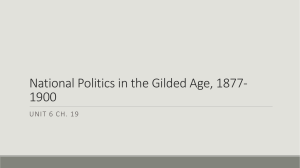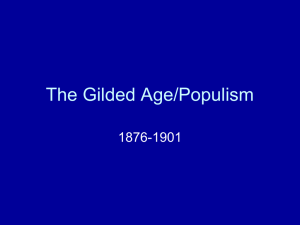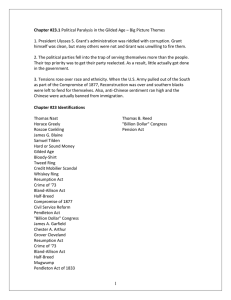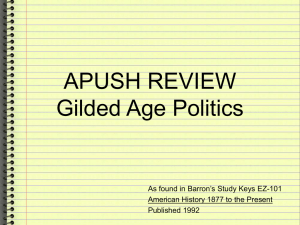5-GildedPolitics
advertisement
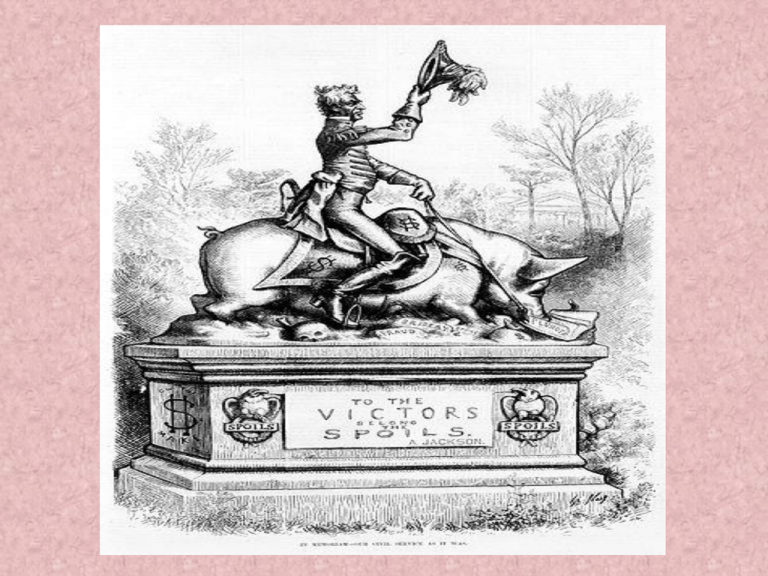
The Gilded Age of America Political Developments 1868-1896 The Grant Administration: 1868-1876 Corruption: The Era of Good Stealings! Credit Mobilier: Railroad people made company Inflated prices, government money Congressmen and the VP took $ Black Friday: Attempt to corner the gold market. Grant allegedly Involved in keeping Gold from being Sold. Indian Ring: Took bribes from businesses supplying goods to reservations Secretary of War resigned The Growth of the Political Machines Tammany Hall: Political Machine that ruled New York under the leadership of William Macy “Boss” Tweed. Cartoons courtesy of Thomas Nast The Two Political Parties during the Gilded Age Democratic Bloc White southerners (preservation of white supremacy) Catholics Recent immigrants (esp. Jews) Urban working poor (pro-labor) Most farmers Republican Bloc Northern whites (pro-business) African Americans Northern Protestants Old WASPs (support for anti-immigrant laws) Most of the middle class GAR (Grand Army of Republic Gold vs. Silver and the Economy Panic of ‘73 Overspending and over lending burst Banks went under Battle of Soft Money vs. Hard Money 1875: Resumption Act led to pulling in more Greenbacks from circulation (deflation) 16 ounces of Silver was equal to 1 ounce of Gold (Legislative Decree) Crime of ‘73: US government dropped coinage of silver dollars. Compromise of 1877 Democrats agreed to accept Republican results from 3 contested states IF: Withdrawal of ALL federal troops in SC and LA End of Radical Reconstruction Black Freedmen no more Union Army protection Redemption for the South 1880 Presidential Election: Republicans Half Breeds compromise Sen. James G. Blaine (Maine) James A. Garfield Stalwarts Sen. Roscoe Conkling (New York) Chester A. Arthur (VP) 1881: Garfield Assassinated! Shot: July 2, 1881 Died: September 19, 1881 Charles Guiteau: I Am a Stalwart, and Arthur is President now! Pendleton Act Civil Service Act. (1883) The “Magna Carta” of civil service reform. Competitive Exams for federal jobs End of Spoils System The Populists In your group do the following 1. Explain what the Populist Part was 2. List supporters and members of the Populist Party 3. Outline specific beliefs that the Populist Party promoted or stood for i.e. their platform 1884 Presidential Election Grover Cleveland * (DEM) Mugwumps bolted to Democrats James Blaine (REP) Rum, Romanism,and Rebellion Cleveland’s Illegitimate child 1888 Presidential Election Grover Cleveland (DEM) Benjamin Harrison * (REP) 1892 Presidential Election Grover Cleveland again! * (DEM) Benjamin Harrison (REP) Hayes Presidency Compromise of 1877 Railroad Strikes Hayes calls in federal troops Garfield/Arthur Presidency Chinese Exclusion Act Pendleton Act Cleveland Presidency Part I Vetoes of Pension Bills Lowers Tariff Though the people support the government, the government should not support the people Harrison Presidency McKinley Tariff Act of 1890 Billion Dollar Congress Sherman Silver Purchase Act of 1890 Homestead steel strike Cleveland Presidency Part II Plessy v. Ferguson Repeal of Sherman Silver Purchase Act Panic of 1893 Wilson-Gorman Tariff Loan from JP Morgan: 65 million in gold Major Political Issues during the Gilded Age Tariff: Explain the forces in favor of a high tariff and the forces against a high tariff. Include both political parties and society in general from Cleveland (I) through Cleveland (II). Money Supply: Explain the pros and cons of bimetallism as well as inflation vs. deflation. Describe which segments of society promoted bimetallism. 1875-1896 Civil Service: Explain how reforming the government job structure splintered the Republican Party As well as the final reform that was legislated to combat the decades old spoils system





